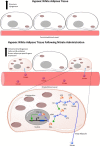Dietary inorganic nitrate: From villain to hero in metabolic disease?
- PMID: 26227946
- PMCID: PMC4863140
- DOI: 10.1002/mnfr.201500153
Dietary inorganic nitrate: From villain to hero in metabolic disease?
Abstract
Historically, inorganic nitrate was believed to be an inert by-product of nitric oxide (NO) metabolism that was readily excreted by the body. Studies utilising doses of nitrate far in excess of dietary and physiological sources reported potentially toxic and carcinogenic effects of the anion. However, nitrate is a significant component of our diets, with the majority of the anion coming from green leafy vegetables, which have been consistently shown to offer protection against obesity, type 2 diabetes and metabolic diseases. The discovery of a metabolic pathway in mammals, in which nitrate is reduced to NO, via nitrite, has warranted a re-examination of the physiological role of this small molecule. Obesity, type 2 diabetes and the metabolic syndrome are associated with a decrease in NO bioavailability. Recent research suggests that the nitrate-nitrite-NO pathway may be harnessed as a therapeutic to supplement circulating NO concentrations, with both anti-obesity and anti-diabetic effects, as well as improving vascular function. In this review, we examine the key studies that have led to the re-evaluation of the physiological function of inorganic nitrate, from toxic and carcinogenic metabolite, to a potentially important and beneficial agent in the treatment of metabolic disease.
Keywords: Adipose Tissue; Diabetes; Dietary inorganic nitrate; Metabolic disease; Metabolism; Nitric oxide; Obesity.
© 2015 The Authors. Molecular Nutrition & Food Research published by Wiley-VCH Verlag GmbH & Co. KGaA, Weinheim.
Figures



Similar articles
-
Vascular effects of dietary nitrate (as found in green leafy vegetables and beetroot) via the nitrate-nitrite-nitric oxide pathway.Br J Clin Pharmacol. 2013 Mar;75(3):677-96. doi: 10.1111/j.1365-2125.2012.04420.x. Br J Clin Pharmacol. 2013. PMID: 22882425 Free PMC article.
-
Therapeutic effects of inorganic nitrate and nitrite in cardiovascular and metabolic diseases.J Intern Med. 2016 Apr;279(4):315-36. doi: 10.1111/joim.12441. Epub 2015 Nov 2. J Intern Med. 2016. PMID: 26522443 Review.
-
Direct comparison of inorganic nitrite and nitrate on vascular dysfunction and oxidative damage in experimental arterial hypertension.Nitric Oxide. 2021 Sep 1;113-114:57-69. doi: 10.1016/j.niox.2021.06.001. Epub 2021 Jun 4. Nitric Oxide. 2021. PMID: 34091009
-
Modulation of mitochondria and NADPH oxidase function by the nitrate-nitrite-NO pathway in metabolic disease with focus on type 2 diabetes.Biochim Biophys Acta Mol Basis Dis. 2020 Aug 1;1866(8):165811. doi: 10.1016/j.bbadis.2020.165811. Epub 2020 Apr 25. Biochim Biophys Acta Mol Basis Dis. 2020. PMID: 32339643 Review.
-
Effects of long-term nitrate supplementation on carbohydrate metabolism, lipid profiles, oxidative stress, and inflammation in male obese type 2 diabetic rats.Nitric Oxide. 2018 May 1;75:27-41. doi: 10.1016/j.niox.2018.02.002. Epub 2018 Feb 10. Nitric Oxide. 2018. PMID: 29432804
Cited by
-
Supplementation with nitrate only modestly affects lipid and glucose metabolism in genetic and dietary-induced murine models of obesity.J Clin Biochem Nutr. 2020 Jan;66(1):24-35. doi: 10.3164/jcbn.19-43. Epub 2019 Nov 12. J Clin Biochem Nutr. 2020. PMID: 32001953 Free PMC article.
-
Standard and New Echocardio Techniques, Such as Global Longitudinal Strain, to Monitor the Impact of Diets on Cardiovascular Diseases and Heart Function.Nutrients. 2024 May 13;16(10):1471. doi: 10.3390/nu16101471. Nutrients. 2024. PMID: 38794710 Free PMC article. Review.
-
Chronic inorganic nitrate supplementation does not improve metabolic health and worsens disease progression in mice with diet-induced obesity.Am J Physiol Endocrinol Metab. 2025 Jan 1;328(1):E69-E91. doi: 10.1152/ajpendo.00256.2024. Epub 2024 Dec 9. Am J Physiol Endocrinol Metab. 2025. PMID: 39653040 Free PMC article.
-
Long-Term Dietary Nitrate Supplementation Does Not Prevent Development of the Metabolic Syndrome in Mice Fed a High-Fat Diet.Int J Endocrinol. 2018 Aug 5;2018:7969750. doi: 10.1155/2018/7969750. eCollection 2018. Int J Endocrinol. 2018. PMID: 30174691 Free PMC article.
-
The potential role of nitrate, a nitric oxide donor, in the prevention and treatment of diabetic osteoporosis.Front Endocrinol (Lausanne). 2025 Jun 12;16:1480838. doi: 10.3389/fendo.2025.1480838. eCollection 2025. Front Endocrinol (Lausanne). 2025. PMID: 40575264 Free PMC article. Review.
References
-
- Grosse, Y. , Baan, R. , Straif, K. , Secretan, B. et al., Carcinogenicity of nitrate, nitrite, and cyanobacterial peptide toxins. Lancet Oncol. 2006, 7(8), 628–629. - PubMed
-
- Buiatti, E. , Palli, D. , Decarli, A. , Amadori, D. et al., A case‐control study of gastric cancer and diet in Italy: II. Association with nutrients. Int. J. Cancer. 1990, 45(5), 896–901. - PubMed
-
- Mayne, S. T. , Risch, H. A. , Dubrow, R. , Chow, W. H. et al., Nutrient intake and risk of subtypes of esophageal and gastric cancer. Cancer Epidemiol. Biomarkers Prev. 2001, 10(10), 1055–1062. - PubMed
-
- Toxicology and carcinogenesis studies of sodium nitrite (CAS NO. 7632‐00‐0) in F344/N rats and B6C3F1 mice (drinking water studies). Natl. Toxicol. Program Tech. Rep. Ser. 2001, 495, 7–273. - PubMed
Publication types
MeSH terms
Substances
Grants and funding
- UD99999906/MRC_/Medical Research Council/United Kingdom
- BHF_/British Heart Foundation/United Kingdom
- Bb/H013539/2/BB_/Biotechnology and Biological Sciences Research Council/United Kingdom
- 093148/Z/10/Z/WT_/Wellcome Trust/United Kingdom
- bb/I000933/I/BB_/Biotechnology and Biological Sciences Research Council/United Kingdom
LinkOut - more resources
Full Text Sources
Other Literature Sources
Medical

